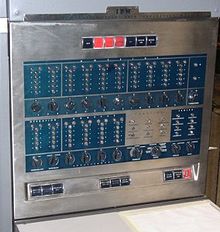Decimal computer
This allowed otherwise low-end machines to offer practical performance for roles like accounting and bookkeeping, and many low- and mid-range systems of the era were decimal based.During the 1970s, microprocessors with instructions supporting decimal arithmetic became common in electronic calculators, cash registers and similar roles, especially in the 8-bit era.The VAX line of 32-bit binary computers from Digital Equipment Corporation, introduced in 1977, also includes packed decimal integer arithmetic instructions.Support for BCD was common in early microprocessors, which were often used in roles like electronic calculators and cash registers where the math was all decimal.These instructions convert one-byte BCD numbers (packed and unpacked) to binary format before or after arithmetic operations.Decimal integer support had been part of their mainframe line, and as part of the broader effort to merge the iSeries and zSeries decimal arithmetic was added to the POWER line so that a single processor could support workloads from these older machines with full performance.
bi-quinary coded decimalcomputernumbersaddressesdecimalbinaryword lengthinput and outputaccountingbookkeepingIBM System/360microprocessorselectronic calculatorscash registersMotorola 68000POWER6System/360computersIBM NORCIBM 650IBM 1620IBM 7070UNIVAC Solid State 80binary-coded decimalbi-quinarytwo-out-of-five codeword addressingexcess-3alphanumericUNIVAC IUNIVAC IIIBM 702IBM 705IBM 1400IBM 7010IBM 7080Honeywell 800IBM 7090integer arithmeticfloating-pointpacked decimalHoneywell 6000 seriesGE-600 seriesmidrange computersSystem/3Digital Equipment CorporationBurroughs Medium SystemsIntel 8080MOS 6502Zilog Z80Motorola 6800Intel BCD opcodespacked and unpacked32-bitColdfireThe 2008 revision of the IEEE 754 floating-point standardsignificandsPower ISAiSerieszSeriesdensely packed decimalz/ArchitectureIBM System z9Ternary computerJones, Douglas W.Cowlishaw, Mike F.Schmid, HermannJohn Wiley & Sons, Inc.binary-coded decimalsalgorithmsmisprints